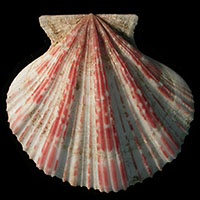|
< Previous family introduction |
|
|||||
 |
Family Pectinidae Scallops
|
|||||
|
The scallops are a large family of worldwide distribution, occurring in temperate, tropical and even polar seas. Large, attractive scallops have been recognised in decorative and architectural motifs since the time of the Romans, and they are a favourite group with collectors. There are 72 species known from Australia, of which nine occur in NSW. Eight of these are restricted to southern Australia, extending to New Zealand in a one instance, while only one of these species has a tropical distribution and that because it has been accidentally introduced. Scallops generally occur in the low intertidal down to bathyal depths (200-2000 m) and a few even reach the hadal zone (below 6000 m). In NSW most scallops occur from the shallow subtidal down to 200 m, but three small species extend down to 1000 m depth. The large, shallow-water species are locally and seasonally common and are fished commercially for food; the Australian Commercial Scallop (Pecten fumatus) and the Doughboy Scallop (Mimachlamys asperrima) are dredged in Tasmania and Victoria, while Ballotís Saucer Scallop (Ylistrum balloti) is harvested in Queensland. Scallops, like other bivalves, are suspension feeders, taking in seawater and extracting solid particle nutrients on the gills, which are passed to the mouth. Some species live attached to solid substrates by a byssus, but others live unattached on the sea floor when adult. Some of the latter are able to swim by flapping their valves. Family Reference Dijkstra, H.H. and Beu, A.G. 2018. Living scallops of Australia and adjacent waters (Mollusca: Bivalvia: Pectinoidea: Propeamussiidae, Cyclochlamydidae, Pectinidae). Records of the Australian Museum 70(2): 113-330. Coverage Al the pectinid species known from NSW are detailed here. Identification notes Scallop shells have a pair of triangular extensions (called auricles) on the dorsal margin which serve to extend the hinge line beyond that possible on a more-or-less circular shell. The relative sizes of the auricles provide a useful taxonomic feature, as in Semipallium aktinos where they are very unequal. The left and right valves may be determined by the position of the byssal notch. The byssus extends through a sinus in the right valve, and so the sinus, through which the foot and byssus extend, is on the anterior side of the shell.
|